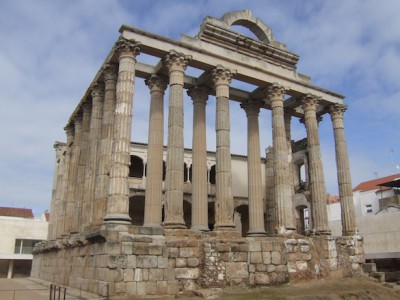MERIDA, SPAIN. Last weekend I took a trip with my study abroad program to a province in Western Spain called Extremadura. Extremadura is one of the 17 autonomous communities of Spain. Since Spain is a decentralized state, these autonomous communities, along with the two autonomous cities, exist in order to preserve the nationalities of each region within Spain. Essentially what this means is that each one has an institution and a government, but still fall under the Spanish nation.
The first place I saw was Mérida, the capital of Extremadura. With a population just under 60,000, Mérida is very different from Madrid, and felt a lot more like the type of Spanish town I had always imagined. It is known for its ancient Roman monuments, of which is has more of than any other city in Spain. In fact it served as the capital of the Lusitania province during the Roman Empire, making it one of the more powerful cities of that time as well. I hadn’t realized I was coming to such an important place!
My favorite part of Mérida, and the Extremadura as a whole, was seeing the contrast between the modern city and the ancient ruins. Obviously, a city continues to develop as we move into the modern age, so there are various shops, hostels, cafés, clubs, etc. Walking through the city felt to me much like walking through my barrio in Madrid, but occasionally you see a 2000-year old aqueduct, an arch, or an old tree. To me it felt like being in a dream: nothing was a surprise.
As we walked through the narrow hall to peer into the Mérida amphitheatre, a thought hit me: “This is the oldest thing I have ever seen.” In the United States, the oldest pieces of architecture I have ever seen are churches in the Northeast, built around the 17th century, and those always seemed so ancient to me. I knew that coming to Europe would expose me to an older world than I had ever fathomed, but there I was, standing in a city that was founded in 25 BC. I realized I was truly in the Old World. This thought remained in my head throughout the rest of my journey, as we continued on to the Roman Theatre, which is still very popular today for events and shows throughout the year. I kept reflecting back to high where we would learn about Roman Theatre, and the types of masks worn by performers to convey certain emotions. At the time, the idea that these ruins exist seemed worlds away, but it was right here. It was so pristine and beautiful, even 2,000 years later; I never wanted to leave.
Exploring a city like Mérida is an interesting experience, and the first one I had ever had like it. It seems like a dream because all these ancient pieces of architecture are scattered throughout a city that is otherwise very modern. They no longer serve their original purpose, so one might wonder why they have not yet been torn down. On the other hand, they are artifacts, they are memories, they are proof of a time so far gone that nothing else remains. To tear these items down would be criminal, it would be to dissolve a memoir of an important time in Rome’s history, an era that has become part of Spain’s history as well.

